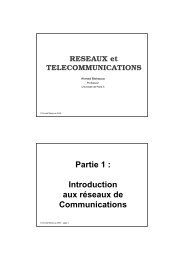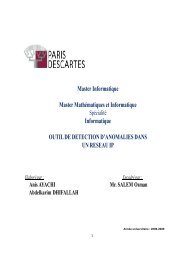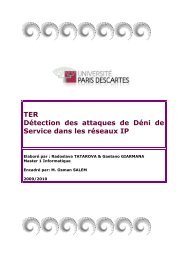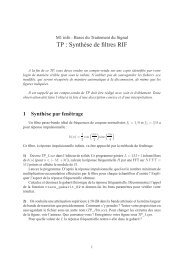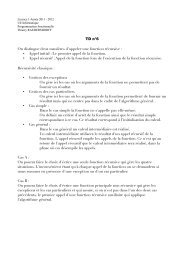Th`ese de Doctorat de l'université Paris VI Pierre et Marie Curie Mlle ...
Th`ese de Doctorat de l'université Paris VI Pierre et Marie Curie Mlle ...
Th`ese de Doctorat de l'université Paris VI Pierre et Marie Curie Mlle ...
You also want an ePaper? Increase the reach of your titles
YUMPU automatically turns print PDFs into web optimized ePapers that Google loves.
of all greedy connections that are routed on link l.<br />
It should be clarified that our proposed algorithms can temporarily present some limita-<br />
tions in bandwidth allocation, since the bandwidth allocated to a user can at most double<br />
from an update interval to the successive one. This could affect the performance of users<br />
that experience steep increases in their transmission rate. In Chapter 7, we evaluate numer-<br />
ically this effect showing at the same time how it is counterbalanced by increased n<strong>et</strong>work<br />
revenue in all the consi<strong>de</strong>red n<strong>et</strong>work scenarios un<strong>de</strong>r several traffic load conditions.<br />
5.2 Convergence Property<br />
The analysis of our algorithms’ convergence property follows closely from [33]. It is shown<br />
in [33] that a distributed algorithm needs at least M iterations to stabilize toward max-min<br />
allocation in a <strong>de</strong>scending or<strong>de</strong>r starting from the most congested bottleneck link, where<br />
M is the number of distinct bottleneck links in the n<strong>et</strong>work.<br />
In practice, the convergence upper-bound can be improved by n<strong>et</strong>work engineering. One<br />
approach is to use a centralized implementation of the bandwidth allocation algorithm.<br />
This effectively removes the M factor from consi<strong>de</strong>ration.<br />
Since SDBA is an exten<strong>de</strong>d version of the max-min fair share algorithm introduced<br />
in [13], the convergence speed of SDBA <strong>de</strong>pends on the s<strong>et</strong> of bottleneck links and how<br />
connections are routed in the n<strong>et</strong>work sharing such bottleneck links. Various traffic sources<br />
can send traffic over the same congested links, a situation that arises frequently in commu-<br />
nication n<strong>et</strong>works. In the extreme case, when all the sources have portions of traffic over all<br />
the congested links, these sources are only constrained by the most congested bottleneck<br />
link. In this case, SDBA takes one round to finish, and the allocation is done with respect<br />
to the capacity of the most congested bottleneck link.<br />
As we have previously <strong>de</strong>scribed, IDBA iterates over SDBA taking into account sources’<br />
offered load to avoid wasting bandwidth, then the convergence speed of IDBA is slightly<br />
48



